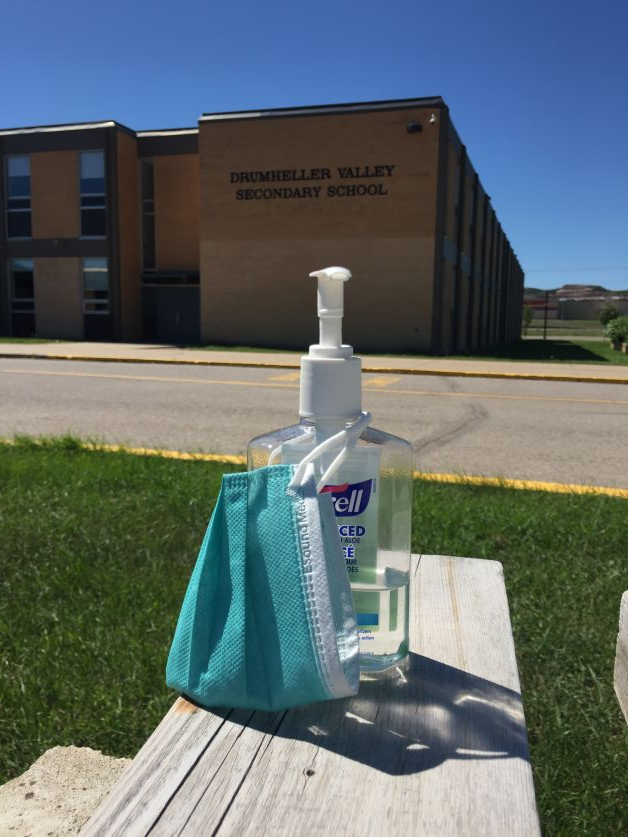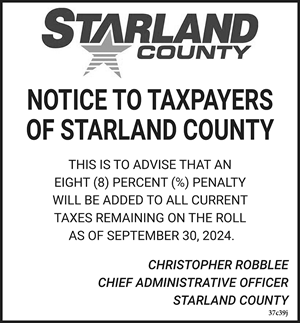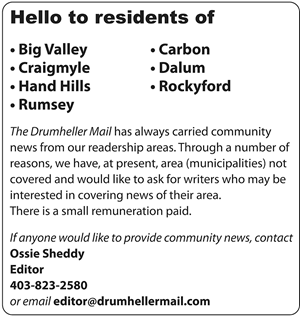
Her Worship Heather Colberg, Mayor of Drumheller gave the Mail an opportunity to catch up with her on a number of topics which the Town of Drumheller has tackled in 2020.
She openly discussed the town’s Flood Mitigation and Resiliency program, the changes to the Municipal Development Plan and Land Use Bylaws, the town’s COVID-19 response and relaunch, and current plans for 2021.
1. The Town of Drumheller has been busy over the summer. What projects have been on the go and how close are these to completion?
Our public works crews in all areas have been working exceptionally hard this summer.
Our Infrastructure and Public Works team have completed the median beautification project on the main corridor, repairing the women’s change room at the Aquaplex, tree trimming, removing old signs, and Community Clean up just wrapped up. Currently, we are in the planning and design stages for a scatter garden in our cemetery which will provide a designated area to scatter a loved one’s ashes.
The Drumheller Resiliency and Flood Mitigation Office has been hard at work
inspecting the existing berms and dikes, and sharing the “8 Steps to Changing the Channel” which is the Flood Mitigation Office’s program to put the river at the heart of the community and keep residents informed.
2. Where are we at with the Downtown Area Revitalization Plan, and when can residents expect to see changes in the downtown area?
The Downtown Area Revitalization Plan (DARP) will provide a 15-year vision to initialize the revitalization of downtown Drumheller. The project aims to re-establish the downtown as the cultural and economic hub of the Valley, a destination for locals and visitors, and a vibrant community.
There will be a public presentation by December 2020.
3. The COVID-19 pandemic has cast a shadow on businesses across the world. Are we seeing a turnaround locally for businesses?
We believe the sites and attractions in our valley have done the best they can in these unprecedented times. Some have chosen to not open, some with limited hours and restrictions. As a community, it’s as important as ever to act local.
4. Speaking of the COVID-19 pandemic, the town put a number of things in place early in the pandemic to help prevent the spread locally. What positives, and negatives, came out of those measures? Are there any lasting legacies that have come out of the COVID-19 pandemic that will have long-term potential for the town? (Example: streamlining permit applications)
The Town of Drumheller has made a number of positive changes throughout the COVID-19 pandemic which have potential future use for the community, including equipping the Emergency Operations Centre (EOC), Incident Command system training for staff, improved internal communication tools for staff, adding a number of online services to the town’s website including permits and licensing, online credit card payments, enhancing the Salvation Army food hamper accessibility during the pandemic, and more.
5. Residents are curious to know about the final financial cost the town endured for the COVID-19 measures; can you give us an update on final expenses?
The audit is still in progress and is not yet complete. However, we do have detailed projected expenses reports available.
6. The recreation facilities recently reopened to the public on September 9th, has that gone smoothly?
The teams at the Badlands Community Facility, Drumheller Aquaplex and Memorial Arena have worked very hard to put processes into place to make sure our users and staff are safe. We are fortunate that we have such a dedicated team!
7. Administration has started working on 2021 budgets recently. What are some concerns for budgeting for this next year?
Council continually makes an effort to be as fiscally responsible as possible, and is committed to ensuring taxpayer dollars are expensed appropriately. Certainly the impact of Covid will affect everyone’s budgets next year. We are working with the province to ensure we continue to receive support for our community.
8. The topic of the Municipal Development Plan and the Land Use Bylaw came up during the September 14 council meeting as part of the Flood Mitigation Office’s presentation. Can you explain, for residents, why these documents are important to the growth and development of Drumheller?
As you know, the flood mitigation project is a massive undertaking. To do this right, we need to put the river at the heart of our planning process. That starts with revamping the town’s foundational planning documents, the Municipal Development Plan (MDP) and the Land Use Bylaw (LUB).
The river is at the heart of our community and it needs to be at the heart of these documents as well, so all the decisions that flow from them support the vision for a safe and prosperous Drumheller.
The MDP is the highest level plan for the Drumheller Valley. It provides high-level vision, goals, and policy to direct future growth, land use, and community form. It also provides guidance for subsidiary plans, like recreation, open space, and plans for new and existing neighbourhoods.
The MDP is important because it carries the long-term development intention for the Drumheller Valley.
The Land Use Bylaw (LUB) implements the MDP’s goals and policies. It provides detailed regulations on use and buildings located within each land use district. It is more detailed and prescriptive than the MDP. The Land Use Bylaw is important because it gives physical shape to development and can either invite or inhibit investment.
9. Part of the discussion was also about reducing the current 21 land use bylaw designations down to eight. What will this mean for the Town of Drumheller, and what impacts will this have on future development permits, and those currently pending approval?
A modernized LUB for Drumheller needs to be easy to interpret and administer. To achieve this, the Bylaw should follow in the footsteps of contemporary precedents that de-emphasize use and re-focus on form. Form-based bylaws are imagined on a transect—a gradient of development intensity that runs from least to most intensive forms.
By refocusing on form, these bylaws can greatly reduce the total number of districts, increasing the document’s legibility and focus.
In Drumheller’s case, the total 21 districts can likely be reduced by over 60 per cent, to eight form-based districts. This makes interaction with the Bylaw easier for both applicants and administration. Within these districts, form is the priority. This allows more flexibility and invites creative investment, with reduced threat of inappropriate building types disrupting the character of neighbourhoods. This support for small business creates a key overlap with valley-wide economic development strategies, and adds flexibility for housing types and forms.
10. Will the changes to the Municipal Development Plan and Land Use Bylaw designations impact any development permits which were previously approved by the town? For example: if a development permit for an external building was approved under the previous MDP and LUB but would not have been approved with the changes, will that impact the existing approved development?
The changes to the MDP & LUB will not designate any impact for development permits that were previously approved by the Town.
















